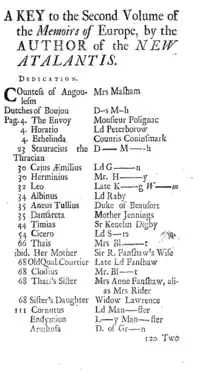Roman à clef
Roman à clef (French pronunciation: [ʁɔmɑ̃ a kle], anglicised as /roʊˌmɒn ə ˈkleɪ/),[1] French for novel with a key, is a novel about real-life events that is overlaid with a façade of fiction.[2] The fictitious names in the novel represent real people, and the "key" is the relationship between the non-fiction and the fiction.[3] This metaphorical key may be produced separately—typically as an explicit guide to the text by the author—or implied, through the use of epigraphs or other literary techniques.[4]

Madeleine de Scudéry created the roman à clef in the 17th century to provide a forum for her thinly veiled fiction featuring political and public figures.[4]
The reasons an author might choose the roman à clef format include satire; writing about controversial topics and/or reporting inside information on scandals without giving rise to charges of libel; the opportunity to turn the tale the way the author would like it to have gone; the opportunity to portray personal, autobiographical experiences without having to expose the author as the subject; avoiding self-incrimination or incrimination of others that could be used as evidence in civil, criminal, or disciplinary proceedings; the ability to change the background and personalities of key participants; and the settling of scores.
Biographically inspired works have also appeared in other literary genres and art forms, notably the film à clef.
See also
Notes
- "Definition of ROMAN À CLEF". www.merriam-webster.com.
- Serafin, Steven R.; Bendixen, Alfred (1 September 2005). The Continuum Encyclopedia of American Literature. A&C Black. p. 525. ISBN 978-0-8264-1777-0.
- Ousby, Ian (23 February 1996). The Cambridge Paperback Guide to Literature in English. Cambridge University Press. ISBN 978-0-521-43627-4.
- Boyde, Melissa (1 November 2009). "The Modernist *roman à clef* and Cultural Secrets, or, I Know that You Know that I Know that You Know". Australian Literary Studies. doi:10.20314/als.dfae519805. ISSN 0004-9697.
References
- Amos, William (1985). The Originals: Who's Really Who in Fiction. London: Cape. ISBN 0-7221-1069-3.
- Busby, Brian (2003). Character Parts: Who's Really Who in CanLit. Toronto: Knopf Canada. ISBN 0-676-97579-8.
- Rintoul, M.C. (2014). Dictionary of Real People and Places in Fiction